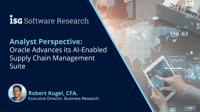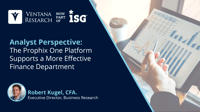When considered at all, unintended consequences are expected to be negative. As enterprises and institutions rush to adopt artificial intelligence and generative AI, the focus is on the potentially unforeseen—and unforecastable—unfavorable outcomes. However, one very likely positive impact of AI investments in business computing is the near-effortless availability of consistently reliable data for whatever task is at hand. This is coming about because of the need to have large, relevant data...
Read More
Topics:
Office of Finance,
Analytics,
Business Planning
The subscription and recurring revenue business models became a significant part of the economy this century with the advent of streaming services for entertainment and software as a service. They have grown in popularity because they enhance customer lifetime value by evolving what had previously been a one-time-sale relationship into a delivery of ongoing services, which can create a more loyal customer relationship as well as provide a regular, more predictable revenue stream.
Read More
Topics:
Office of Finance,
ERP and Continuous Accounting
Doing more with less is the defining characteristic of finance and accounting departments in midsize enterprises, which ISG research defines as organizations with between 100 and 999 workers. One frustrating truth confronting executives in these organizations is that, once their company stops being a small business, it has many of the same challenges that large enterprises face but with fewer resources to deal with them. Over the past two decades, advances in information technology have had the...
Read More
Topics:
Office of Finance,
Business Planning,
ERP and Continuous Accounting,
natural language processing
I recently attended Infor’s Velocity Summit, designed to showcase the latest versions of its CloudSuite ERP software. Also center stage were Infor’s advances in artificial intelligence and process mining as well as its environmental, social and governance application and supply chain optimization enhancements.
Read More
Topics:
Office of Finance,
ERP and Continuous Accounting,
natural language processing,
AI and Machine Learning,
Continuous Supply Chain & ERP
Artificial Intelligence and generative AI are beginning to change how enterprises do many things, especially planning and budgeting. This technology has the potential to significantly redefine the mission of the financial planning and analysis group. It will do so by substantially reducing the time spent on the purely mechanical aspects of day-to-day tasks. AI is also making it easier for executives and managers to rapidly forecast, plan and analyze to promote deeper situational awareness and...
Read More
Topics:
Office of Finance,
Business Planning,
Workforce Management,
Analytics and Data,
AI and Machine Learning
Agents are all the rage—and for a good reason. They are a way to automate work almost effortlessly so that repetitive and boring tasks get done with the least amount of effort on the part of the operator. In business, agents can be a boon for customer satisfaction and a way to improve worker productivity. They are alluring, with an almost unlimited number of potential use cases.
Read More
Topics:
Office of Finance,
Business Planning,
ERP and Continuous Accounting,
natural language processing,
AI and Machine Learning,
Digital Applications,
Order-to-Cash
Oracle announced significant updates to its Fusion Cloud Supply Chain & Manufacturing (SCM) software at the recently held Oracle Cloud World. The application suite includes procurement, inventory management, warehouse management, order management and transportation management. SCM tasks are mostly small-scale and repetitive, yet the processes they support are far from simple. They involve the intricate choreography of often complex activities that require the accurate communication and...
Read More
Topics:
Operations & Supply Chain,
AI,
AI and Machine Learning,
Continuous Supply Chain & ERP,
Digital Applications
Artificial intelligence-enabled business applications have advanced considerably over the past year as software providers have added a steady stream of capabilities. This includes customer facing, financial, supply chain and workforce software. ISG Research asserts that by 2027, almost all providers of business applications will use some form of generative AI to enhance capabilities and functionality to remain competitive.
Read More
Topics:
Office of Finance,
Business Planning,
ERP and Continuous Accounting,
AI and Machine Learning
Prophix launched its Prophix One platform earlier this year. CFOs of midsize enterprises should take a look at it because it supports a more effective approach to finance and accounting operations in growing companies. It facilitates the transition of organizations that can no longer make do with work-arounds of existing systems to those with formal, controlled core processes that can be completed faster with reduced risk. The platform performs financial consolidation, account reconciliation...
Read More
Topics:
Office of Finance,
Business Planning,
ERP and Continuous Accounting,
AI and Machine Learning
Sage recently held an analyst summit to take a deeper dive into its product and technology roadmap, complementing sessions it held at its 2024 user group conference that I commented on earlier this year. ERP systems have been central to the operational and financial management of enterprises since they first appeared in the 1990s. They are so familiar that they have become part of the background and only noticeable when something fails. We are now in a major transition to a new era of...
Read More
Topics:
Office of Finance,
ERP and Continuous Accounting




















